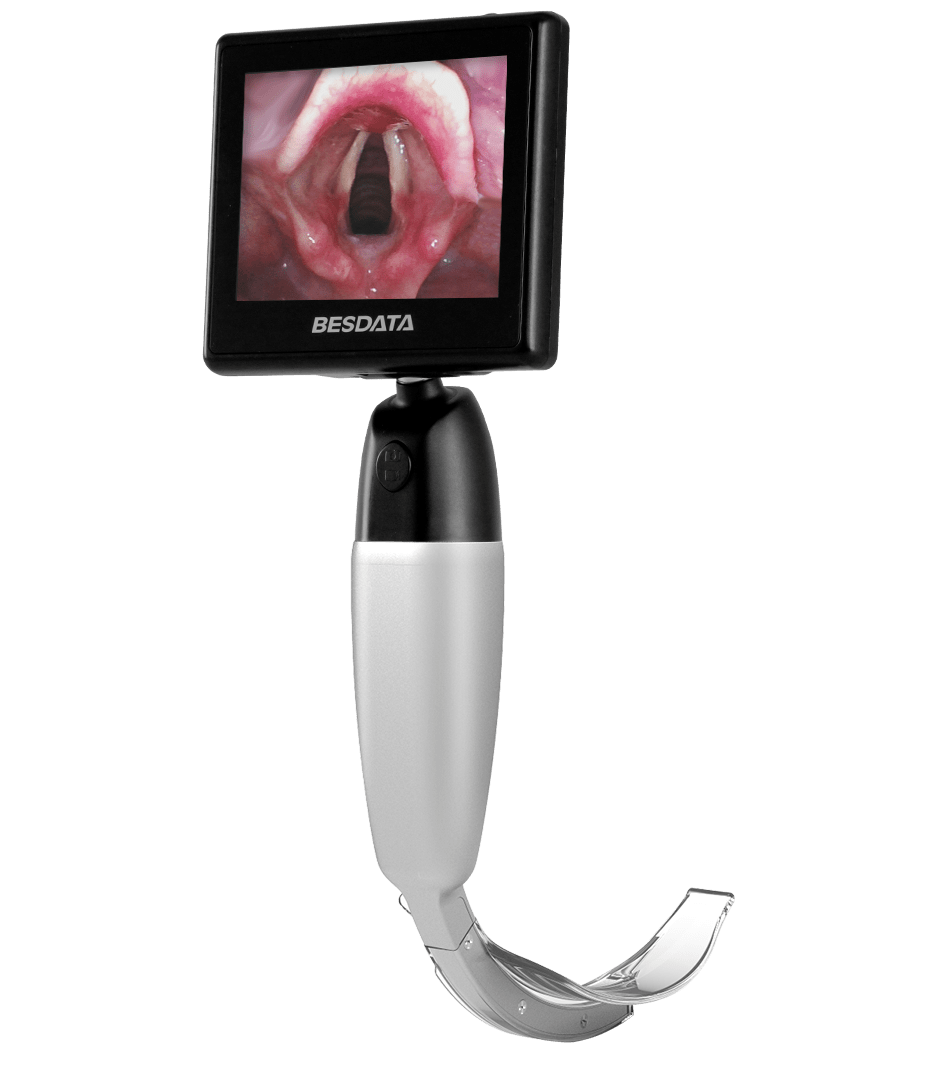Videolaryngoscopes: Structure, purpose and evidence

Videolaryngoscope BF-DP
Is an aid for endotracheal intubation. Equipped with MAC and MIL handle, it is suitable for ...
In recent years, video laryngoscopes have established themselves as indispensable instruments in anesthesia and emergency medicine. They enable improved visualization of the laryngeal structures, which increases the success rate of endotracheal intubation, especially in difficult airway conditions [1].
Setup of video laryngoscopes
A video laryngoscope consists of several essential components:
- Blades: It is inserted into the mouth to push the tongue aside and allow a view of the glottis. There are different types of blades for different applications:
- Macintosh-like blade (enables direct and indirect vision)
- Hyperangulated blade (suitable for difficult airway conditions) [2].
- Miller blade (suitable for use with neonates; see also here: Overview of spatulas)
- Camera: A miniature camera attached to the tip of the spatula transmits the image in real time to a monitor [3].
- Light source: An LED light source ensures optimum illumination of the airways [4].
- Monitor: The recorded image is displayed on an external or integrated monitor, which enables precise positioning of the endotracheal tube [5].
Purpose of video laryngoscopes
The main purpose of video laryngoscopes is the safe and efficient performance of endotracheal intubation. The most important areas of application include
- Regular intubation: Video laryngoscopes are increasingly being used as a standard procedure, particularly in anesthesia [6].
- Difficult airway: The S1 guideline on airway management recommends the primary use of video laryngoscopes in difficult intubation conditions [7].
- Emergency medicine: Improved visibility of the airway can increase the success rate of emergency intubations [8].
- Medical training: Due to the real-time display on a monitor, video laryngoscopes are ideal for training anesthesiologists and emergency physicians [9].
Scientific evidence and current guidelines
According to the current S1 guideline “Airway management” of the German Society of Anesthesiology and Intensive Care Medicine (DGAI) [7], a video laryngoscope should be available at every anesthesiology workplace. The most important recommendations are
- Videolaryngoscopes with a Macintosh-like blade are suitable as the primary instrument for intubation [7].
- If a difficult airway is expected, hyperangulated blades should be available [10].
- After an unsuccessful direct laryngoscopy, the use of a video laryngoscope is recommended [7].
- Videolaryngoscopy is the preferred method for securing the airway, particularly in patients at risk of aspiration [11].
The introduction of video laryngoscopes has significantly improved the clinical practice of airway management. Their benefits, especially in difficult situations, are well documented by scientific studies and guidelines. Their routine use is increasingly seen as standard and adequate training is essential to maximize the potential of this technology.
[1] Aziz, M. F., Healy, D., Kheterpal, S., et al. (2011). “Routine Clinical Practice Effectiveness of the Glidescope in Difficult Airway Management: An Analysis of 2,004 Glidescope Intubations, Complications, and Failures From a Prospective, Multicenter, Observational Study.” Anesthesiology, 114(1), 34-41.
[2] Mosier, J. M., Sakles, J. C., Law, J. A., et al. (2020). “Tracheal Intubation in the Critically Ill: Current Status and Future Directions.” The Lancet Respiratory Medicine, 8(8), 754-766.
[Cook, T. M., Kelly, F. E. (2017). “A National Survey of Videolaryngoscopy in the United Kingdom.” Anaesthesia, 72(8), 1017-1024.
[4] Pieters, B. M., Maas, E., Knape, J. T. A., et al. (2017). “Videolaryngoscopy vs. Direct Laryngoscopy for Tracheal Intubation in Adults with Obesity: A Systematic Review and Meta-analysis.” Anaesthesia, 72(6), 691-701.
[5] Myatra, S. N., Jain, R., Gandhi, K., et al. (2013). “Comparison of the C-MAC Videolaryngoscope with the Macintosh Laryngoscope for Routine Airway Management: A Randomized Clinical Study.” Anaesthesia, 68(9), 899-907.
[6] Apfelbaum, J. L., Hagberg, C. A., Caplan, R. A., et al. (2013). “Practice Guidelines for Management of the Difficult Airway: An Updated Report by the American Society of Anesthesiologists Task Force on Management of the Difficult Airway.” Anesthesiology, 118(2), 251-270.
[7] German Society for Anesthesiology and Intensive Care Medicine (DGAI). (2023). “S1 guideline on airway management.” AWMF register number: 001-028. Available at: https://register.awmf.org/assets/guidelines/001-028l_S1_Atemwegsmanagement_2023-09.pdf (accessed on February 04, 2025).
[8] Brown, C. A., Bair, A. E., Pallin, D. J., et al. (2010). “Techniques, Success, and Adverse Events of Emergency Department Adult Intubations.” Annals of Emergency Medicine, 56(4), 260-270.
[9] Martin, L. D., Mhyre, J. M., Shanks, A. M., et al. (2011). “3,423 Emergency Tracheal Intubations at a University Hospital: Airway Outcomes and Complications.” Anesthesiology, 114(1), 42-48.
[10] Piepho, T., Werner, C., Noppens, R. (2015). “Evaluation of the C-MAC Videolaryngoscope for Nasotracheal Intubation.” Anaesthesia, 70(2), 134-138.
[11] Frerk, C., Mitchell, V. S., McNarry, A. F., et al. (2015). “Difficult Airway Society 2015 Guidelines for Management of Unanticipated Difficult Intubation in Adults.” British Journal of Anaesthesia, 115(6), 827-848.
